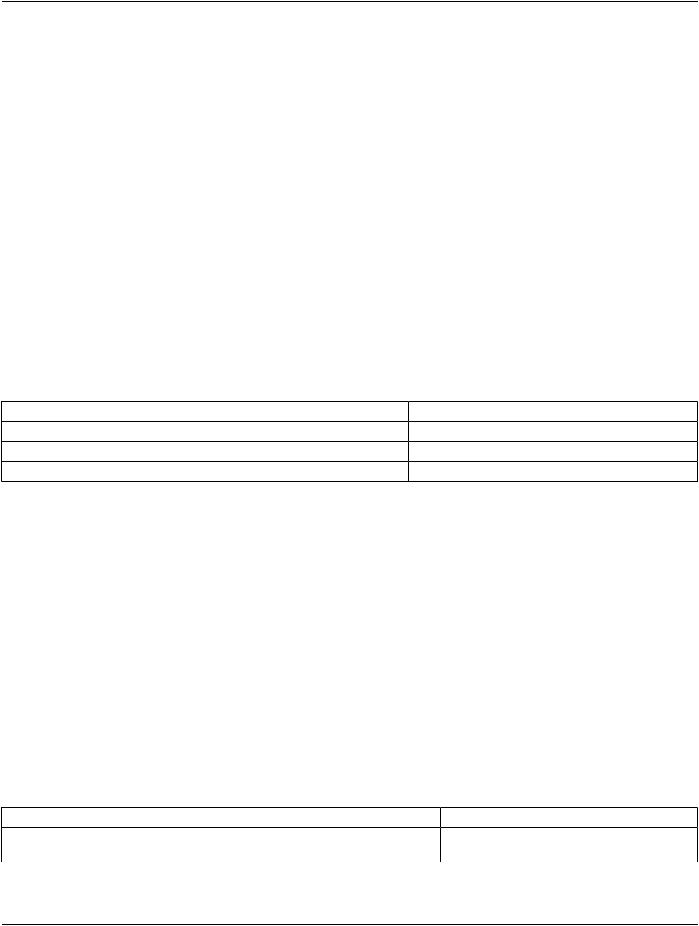
PS-2020a / part04
.pdf
DICOM PS3.4 2020a - Service Class Specifications |
Page 271 |
Q.4.3.3 SOP Classes
The Relevant Patient Information Model SOP Classes in the Relevant Patient Information Query Service Class identify the Relevant Patient Information Model, and the DIMSE-C operation supported. In some instances a Root template is specified. The Standard SOP Classes are defined in Table Q.4-3:
Table Q.4-3. SOP Classes for the Relevant Patient Information Model
SOP Class Name |
SOP Class UID |
|
Root Template |
General Relevant Patient Information Query1.2.840.10008.5.1.4.37.1 |
TID 9007 |
General Relevant Patient Information, |
|
|
|
or from the list in PS3.16 |
|
Breast Imaging Relevant Patient Information1.2.840.10008.5.1.4.37.2 |
TID 9000 |
Relevant Patient Information for Breast |
|
Query |
|
Imaging |
|
Cardiac Relevant Patient Information Query1.2.840.10008.5.1.4.37.3 |
TID 3802 |
Cardiovascular Patient History |
|
Note
The list of Root templates for the General Relevant Patient Information Query is extensible.
Q.5 Relevant Patient Information Query Example (Informative)
Moved to PS3.17.
- Standard -

Page 272 |
DICOM PS3.4 2020a - Service Class Specifications |
- Standard -

DICOM PS3.4 2020a - Service Class Specifications |
Page 273 |
R Instance Availability Notification Service
Class (Normative)
R.1 Overview
R.1.1 Scope
The Instance Availability Notification Service Class defines an application-level class-of-service that allows one DICOM AE to notify another DICOM AE of the presence and availability of SOP instances that may be retrieved. The AE from which such SOP Instances can later be retrieved may or may not be the SCU performing the notification.
Note
An example of usage of this Service Class is for the receiver of the instances to provide notification of their arrival and availability for subsequent workflow steps to a different entity, such as a separate workflow manager.
The SCU implementation defines the conditions under which it provides the notification. Certain SCUs may provide notification for arbitrary sets of SOP Instances, while other SCUs may provide notification when they determine that the instances associated with aProcedureSteporaRequestedProcedureareavailable.TheSCUisrequiredtodocumentinitsConformanceStatementthenature of its notification decisions (e.g., frequency of notifications, retrieve capabilities and latency, etc.).
Once the SCU has provided notification about availability of the SOP Instances, the SCP may use that information in directing further workflow, such as in populating the Input Information Sequence when forming a Unified Procedure Step. These types of policies are outside the scope of this Standard, however, the SCP is required to document these policies in its Conformance Statement.
The SCU of this Service Class is not required to assure that the study, procedure step or any workflow-related entity is "complete"; indeed no semantics other than the concept of "availability" is expressed or implied by the use of this service.
Note
1.The Performed Workitem Code Sequence (0040,4019) Attribute of a referenced GP-PPS instance may provide the specific description of the work item that triggered the Instance Availability Notification.
2.The Instance Availability Notification is typically a service of the composite instance Storage SCP, since that application is responsible for making the instances available. The Instance Availability Notification allows that application to report the specific Retrieve AE Title, which may differ from the Storage Service AE Title, and may vary with different instance SOP Classes, or may vary over time.
R.2 Conformance Overview
The Instance Availability Notification Service Class consists of a single SOP Class: the Instance Availability Notification SOP Class.
The SOP Class specifies Attributes, operations, and behavior applicable to the SOP Class. The conformance requirements shall be specified in terms of the Service Class Provider (SCP) and the Service Class User (SCU).
The Instance Availability Notification Service Class uses the Instance Availability Notification IOD as defined in PS3.3 and the N- CREATE DIMSE Service specified in PS3.7.
R.3 Instance Availability Notification SOP Class
R.3.1 DIMSE Service Group
TheDIMSEServicesshowninTable R.3.1-1areapplicableto theInstanceAvailabilityNotificationIODundertheInstanceAvailability
Notification SOP Class.
- Standard -

Page 274 DICOM PS3.4 2020a - Service Class Specifications
Table R.3.1-1. DIMSE Service Group Applicable to Instance Availability Notification
DICOM Message Service Element |
Usage SCU/SCP |
N-CREATE |
M/M |
The DIMSE Services and Protocols are specified in PS3.7. |
|
Note |
|
Though the terminology "notification" is used for this Service Class, the notification is in fact performed through Operations rather than Notifications.
R.3.2 Operations
The Application Entity that claims conformance to this SOP Class as an SCU shall be permitted to invoke the following operations and the Application Entity that claims conformance as an SCP shall be capable of providing the following operations.
R.3.2.1 N-CREATE Instance Availability Notification SOP Instance
This operation allows an SCU to create an instance of the Instance Availability Notification SOP Class and to provide availability in- formation about Instances that are under the control of the SCU. This operation shall be invoked through the DIMSE N-CREATE Service.
R.3.2.1.1 Attributes
The Attribute list of the N-CREATE is defined as shown in Table R.3.2-1.
Table R.3.2-1. Instance Availability Notification SOP Class N-CREATE Attributes
Attribute Name |
Tag |
Req. Type N-CREATE |
|
|
(SCU/SCP) |
Specific Character Set |
(0008,0005) |
1C/1C |
|
|
(Required if an extended or |
|
|
replacementcharactersetisused) |
All other Attributes of the SOP Common Module |
|
3/3 |
Referenced Performed Procedure Step Sequence |
(0008,1111) |
2/2 |
>Referenced SOP Class UID |
(0008,1150) |
1/1 |
>Referenced SOP Instance UID |
(0008,1155) |
1/1 |
>Performed Workitem Code Sequence |
(0040,4019) |
2/2 |
 >>Include Table 8-1a “Enhanced SCU/SCP Coded Entry Macro with SCU Support, Matching Key Support and Mandatory Meaning”
>>Include Table 8-1a “Enhanced SCU/SCP Coded Entry Macro with SCU Support, Matching Key Support and Mandatory Meaning”
Study Instance UID |
(0020,000D) |
1/1 |
Referenced Series Sequence |
(0008,1115) |
1/1 |
>Series Instance UID |
(0020,000E) |
1/1 |
>Referenced SOP Sequence |
(0008,1199) |
1/1 |
>>Referenced SOP Class UID |
(0008,1150) |
1/1 |
>>Reference SOP Instance UID |
(0008,1155) |
1/1 |
>>Instance Availability |
(0008,0056) |
1/1 |
>>Retrieve AE Title |
(0008,0054) |
1/1 |
>>Retrieve Location UID |
(0040,E011) |
3/3 |
>>Retrieve URI |
(0040,E010) |
3/3 |
>>Retrieve URL |
(0008,1190) |
3/3 |
- Standard -

|
DICOM PS3.4 2020a - Service Class Specifications |
Page 275 |
Attribute Name |
Tag |
Req. Type N-CREATE |
|
|
(SCU/SCP) |
>>Storage Media File-Set ID |
(0088,0130) |
3/3 |
>>Storage Media File-Set UID |
(0088,0140) |
3/3 |
R.3.2.1.2 Service Class User
The SCU shall specify in the N-CREATE request primitive the SOP Class and SOP Instance UIDs of the Instance Availability Notific- ation SOP Instance that is created and for which Attribute Values are to be provided.
The SCU shall provide Attribute Values for the Instance Availability Notification SOP Class Attributes as specified in Table R.3.2-1.
The use of additional optional Attributes by the SCU is forbidden.
Note
The reason for forbidding optional Attributes is to prevent the use of Standard Extended SOP Classes that might add con- textual information such as patient and procedure identifiers.
The encoding rules for Instance Availability Notification Attributes are specified in the N-CREATE request primitive specification in PS3.7.
There are no requirements on when N-CREATE requests are required to be performed.
In particular, there are no requirements that notification about the availability of the first instance of a Performed Procedure Step or Studybeprovideduponitsreception,northatavailabilitynotificationbeprovidedwhenanentiresetofinstancescomprisingacompleted Performed Procedure Step or Study are available, though these are typical and common scenarios.
R.3.2.1.3 Service Class Provider
The SCP shall return, via the N-CREATE response primitive, the N-CREATE Response Status Code applicable to the associated request.
R.3.2.1.4 Status Codes
There are no specific status codes. See PS3.7 for response status codes.
R.3.3 Instance Availability Notification SOP Class UID
The Instance Availability Notification SOP Class shall be uniquely identified by the Instance Availability Notification SOP Class UID, which shall have the value "1.2.840.10008.5.1.4.33".
R.3.4 Conformance Requirements
Implementations shall include within their Conformance Statement information as described below.
An implementation may conform to this SOP Class as an SCU or as an SCP. The Conformance Statement shall be in the format defined in Annex A “DICOM Conformance Statement Template (Normative)” in PS3.2.
R.3.4.1 SCU Conformance
An implementation that is conformant to this SOP Class as an SCU shall meet conformance requirements for the operations that it invokes.
R.3.4.1.1 Operations
Any Attributes for which Attribute Values may be provided (using the N-CREATE) by the SCU shall be enumerated in the SCU Con- formance Statement. The SCU Conformance Statement shall be formatted as defined in Annex A “DICOM Conformance Statement Template (Normative)” in PS3.2.
- Standard -

Page 276 |
DICOM PS3.4 2020a - Service Class Specifications |
An implementation that conforms to this SOP Class as an SCU shall specify under which conditions during the performance of real- world activities it will create the SOP Class Instance.
The SCU Conformance Statement shall specify what is meant by each reported value of Instance Availability (0008,0056).
The SCU Conformance Statement shall describe the relationship between the Instance Availability Notification and the Performed Procedure Step SOP Classes, if the latter are supported.
R.3.4.2 SCP Conformance
An implementation that is conformant to this SOP Class as an SCP shall meet conformance requirements for the operations that it performs.
R.3.4.2.1 Operations
The SCP Conformance Statement shall be formatted as defined in Annex A “DICOM Conformance Statement Template (Normative)”
in PS3.2.
The SCP Conformance Statement shall provide information on the behavior of the SCP (in terms of real world activities) for each re- ported value of Instance Availability (0008,0056).
The SCP Conformance Statement shall describe the behavioral relationship between the Instance Availability Notification and the Performed Procedure Step SOP Classes, if the latter are supported.
- Standard -

DICOM PS3.4 2020a - Service Class Specifications |
Page 277 |
SMediaCreationManagementServiceClass (Normative)
S.1 Overview
S.1.1 Scope
The Media Creation Management Service Class defines a mechanism by which an SCU can instruct a device to create Interchange MediacontainingasetofCompositeSOPInstancesthathavealreadybeentransferredtothemediacreationdeviceusingtheStorage Service Class.
ThisServiceClassdoesnotaddressarchivalstoragerequirements.Itisintendedonlyforthemanagementofmediacreationdevices. ThereisnorequirementbytheStandardthatanSCPofthisServiceClasswillcommittotakingresponsibilityforarchivalofComposite Instances, such that an SCU may then discard them. Such behavior is entirely outside the scope of the Standard. In other words, Media Creation does not imply Storage Commitment.
The application profile(s) for the set of instances, which implies the form of the media created (i.e., CD, DVD or MOD), can either be left to the discretion of the SCP, or explicitly specified in the media creation request. In the latter case, if the device is unable to create the requested profiles, an error shall be returned.
Note
1.More than one profile may be requested or used by default, since the requested set of instances may not be compatible with a single profile. DICOM media may always contain instances written by more than one profile. See PS3.2.
2.It is the responsibility of the SCU to negotiate and store instances with an appropriate Transfer Syntax should a specific Transfer Syntax be required by a requested profile. The SCP is not required to support compression or decompression of stored instances in order to convert stored instances into a form suitable for a requested profile. It may do so, if so requested, but the level of lossy compression would be at the discretion of the SCP. If the degree of compression is important to the application, then the SCU may compress the images before sending them to the SCP.
The request controls whether or not a label is to be generated on the media, be it from information contained in the instances (such as patient demographics) or from text explicitly specified in the request.
Note
1.AnSCPmayormaynotbephysicallycapableoflabelingthemedia.Thiscapabilityisoutsidethescopeofconformance to the Standard. Inability to create a label is not an error.
2.De-identification of instances (and labels), such as for teaching file media or clinical trial media is the responsibility of the SCU and is outside the scope of this service. That is, the SCU must de-identify the composite instances before sending them, prior to the media creation request.
The Service Class contains a limited capability to return status information. A media creation request may initially either fail or be accepted. Subsequently, the SCP may be polled as to the status of the request (idle, pending/creating, successful or failed) by the SCU on the same or on a separate Association. There is no asynchronous notification. There is no dependence on the duration or persistence of an Association.
Note
There is no requirement to manage the handling of transient failures (such as an empty supply of blank media or labels or ink). Whether or not the SCP queues stored instances and requests in such cases, or fails to accept the request, is outside the scope of the Standard.
S.2 Conformance Overview
The application-level services addressed by this Service Class are specified via the Media Creation Management SOP Class.
- Standard -

Page 278 |
DICOM PS3.4 2020a - Service Class Specifications |
TheMediaCreationManagementSOPClassspecifiesAttributes,operationsandbehaviorapplicabletotheSOPClass.Theconform- ance requirements shall be specified in terms of the Service Class Provider (SCP) and the Service Class User (SCU).
The Media Creation Management Service Class uses the Media Creation Management IOD as defined in PS3.3 and the N-CREATE, N-ACTION and N-GET Services specified in PS3.7.
S.2.1 Association Negotiation
AssociationestablishmentisthefirstphaseofanyinstanceofcommunicationbetweenpeerDICOMAEs.TheAssociationnegotiation rules as specified in PS3.7 shall be used to negotiate the supported SOP Classes.
Support for the SCP/SCU role selection negotiation is not applicable. The SOP Class Extended Negotiation is not defined for this Service Class.
S.3 Media Creation Management SOP Class
The SCU transmits the SOP Instances to the SCP using the Storage Service Class. The request for media creation is transmitted to theSCPandcontainsalistofreferencestooneormoreSOPInstances.Successorfailureofmediacreationissubsequentlyindicated by the SCU requesting the status from the SCP on the same or a separate association.
S.3.1 DIMSE Service Group
The following DIMSE-N Services are applicable to the Media Creation Management SOP Class.
Table S.3.1-1. DIMSE Service Group Applicable to Media Creation Management
DICOM Message Service Element |
Usage SCU/SCP |
N-CREATE |
M/M |
N-ACTION |
M/M |
N-GET |
U/M |
The DIMSE-N Services and Protocol are specified in PS3.7. |
|
S.3.2 Operations
The DICOM AEs that claim conformance to this SOP Class as an SCU shall invoke the N-CREATE and the N-ACTION operations. The DICOM AEs that claim conformance to this SOP Class as an SCP shall support the N-CREATE, the N-ACTION and the N-GET operations.
S.3.2.1 Create a Media Creation Request
The Create a Media Creation Request operation allows an SCU to create an instance of the Media Creation Management SOP Class and initialize Attributes of the SOP Class. The SCP uses this operation to create a new media creation request containing the set of SOP Instances that shall be included in the Interchange Media. This operation shall be invoked through the N-CREATE primitive
S.3.2.1.1 Attributes
The DICOM AEs that claim conformance to this SOP Class as an SCU may choose to provide a subset of the Attributes maintained by the SCP. The DICOM AEs that claim conformance to this SOP Class as an SCP shall support a subset of the Media Creation Management specified in Table S.3.2.1.1-1.
Table S.3.2.1.1-1. Media Creation Management - N-CREATE Attributes
Attribute Name |
Tag |
Requirement Type SCU/SCP |
Specific Character Set |
(0008,0005) |
1C/1C (Required if expanded or replacement |
|
|
character set is used) |
- Standard -

DICOM PS3.4 2020a - Service Class Specifications |
Page 279 |
||
Attribute Name |
Tag |
Requirement Type SCU/SCP |
|
Storage Media File-Set ID |
(0088,0130) |
|
3/3 |
|
|
|
See Section S.3.2.1.1.1. |
Storage Media File-Set UID |
(0088,0140) |
|
3/3 |
|
|
|
See Section S.3.2.1.1.1. |
LabelUsingInformationExtractedFromInstances |
(2200,0001) |
|
3/1C |
|
|
|
See Section S.3.2.1.1.4. |
Label Text |
(2200,0002) |
|
3/1C |
|
|
|
See Section S.3.2.1.1.4. |
Label Style Selection |
(2200,0003) |
|
3/1C |
|
|
|
See Section S.3.2.1.1.4. |
Barcode Value |
(2200,0005) |
|
3/3 |
|
|
|
See Section S.3.2.1.1.4 |
Barcode Symbology |
(2200,0006) |
|
3/3 |
|
|
|
See Section S.3.2.1.1.4 |
Media Disposition |
(2200,0004) |
|
3/3 |
|
|
|
See Section S.3.2.1.1.5. |
Allow Media Splitting |
(2200,0007) |
|
3/1C |
|
|
|
See Section S.3.2.1.1.6 |
Allow Lossy Compression |
(2200,000F) |
|
3/1C |
|
|
|
See Section S.3.2.1.1.9 |
Include Non-DICOM Objects |
(2200,0008) |
|
3/1C |
|
|
|
See Section S.3.2.1.1.7 |
Include Display Application |
(2200,0009) |
|
3/1C |
|
|
|
See Section S.3.2.1.1.8 |
Preserve Composite Instances After Media |
(2200,000A) |
|
3/3 |
Creation |
|
|
|
Referenced SOP Sequence |
(0008,1199) |
|
1/1 |
>Referenced SOP Class UID |
(0008,1150) |
|
1/1 |
>Referenced SOP Instance UID |
(0008,1155) |
|
1/1 |
>Requested Media Application Profile |
(2200,000C) |
|
3/1 |
|
|
|
See Section S.3.2.1.1.2. |
>Icon Image Sequence |
(0088,0200) |
|
3/1C |
|
|
|
See Section S.3.2.1.1.3. |
S.3.2.1.1.1 Storage Media File-Set Attributes
Ifpresent,theStorageMediaFile-SetID(0088,0130)andStorageMediaFile-SetUID(0088,0140)shallbeusedonthemediacreated. If absent, the media shall contain values generated by the SCP.
- Standard -

Page 280 |
DICOM PS3.4 2020a - Service Class Specifications |
If the media request will not fit on a single volume (single piece or side of media), then whether or not the SCP ignores Storage Media File-Set ID (0088,0130), or uses it as a prefix and appends information to distinguish volumes, is implementation dependent. Different values of Storage Media File-Set UID (0088,0140) shall be used for different volumes.
If multiple copies are requested, the same Storage Media File-Set ID (0088,0130) and Storage Media File-Set UID (0088,0140) shall be used on all copies.
Note
Care should be taken with multiple copies written to rewritable media that their contents do not diverge even though their identifiers are identical.
S.3.2.1.1.2 Requested Media Application Profile
The Requested Media Application Profile (2200,000C), if present, shall be used by the SCP for the specified SOP Instance. If absent for a particular instance, the choice of Media Application Profile for that instance shall be at the discretion of the SCP.
Note
1.Different Media Application Profiles may be used for different instances on the same piece of media.
2.The form of the DICOMDIR directory records that the SCP must create may be significantly influenced by the media application profiles used.
S.3.2.1.1.3 Icon Image Sequence
The Icon Image Sequence (0088,0200), if present:
•shall be used by the SCP for inclusion in the instance-level DICOM Directory Record for the specified SOP Instance, if the Media Application Profile requires its inclusion, and the icon supplied by the SCU meets the requirements of the profile
•may be used by the SCP for inclusion in the instance-level DICOM Directory Record for the specified SOP Instance, if the Media Application Profile does not require its inclusion
If absent for a particular instance, the choice of Media Application Profile for that instance dictates whether or not the SCP is required to create its own Icon Image Sequence (0088,0200) from the contents of the SOP Instance.
Note
1.Some Media Application Profiles require the inclusion of an Icon Image Sequence (0088,0200) in the directory records.
2.Some Media Application Profiles specify constraints on the form of the Icon Image Sequence (0088,0200).
3.The SCP may choose to extend the Media Application Profile by generating and including icons anyway.
S.3.2.1.1.4 Labeling
The SCP may or may not have the capability to print a label on (or for) the media. If it does, then the following SCP behavior shall apply and the specified Attributes are required to be supported by the SCP.
The Label Using Information Extracted From Instances (2200,0001) Attribute is a flag that instructs the SCP whether or not to create any label using the Patient and Study information contained within the instances themselves.
Note
The SCP may implement whatever it considers to be an appropriate subset of any Attributes of any Modules at the Patient, Specimen and Study entities in the DICOM Information Model specified in PS3.3. Typically included are such Attributes as Patient Name (0010,0010), Patient ID (0010,0020), Study ID (0020,0010), and Study Date (0008,0020).
The Label Text (2200,0002) Attribute is additional text that the SCP shall include on any label, either in addition to or instead of any extracted demographics, depending on the value of Label Using Information Extracted From Instances (2200,0001).
The Label Style Selection (2200,0003) Attribute is a code string, which if present, may be used by the SCP to choose one or more implementation-dependent styles of labeling.
- Standard -
